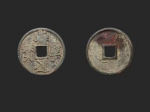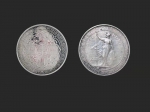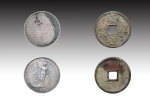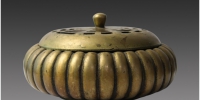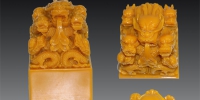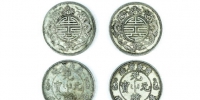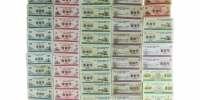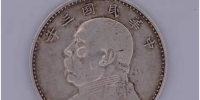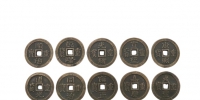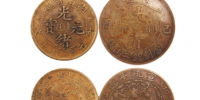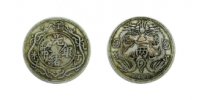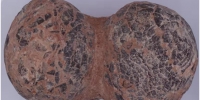2019精品推荐 崇宁通宝、站洋币壹组
成都博古轩拍卖有限公司【藏 . 荐】栏 为藏品强大的传播效应向各位买家推荐经国家一级鉴定专家甄选的艺术珍品 , 为藏家牵线搭桥 , 让千百件艺术珍品价值被发掘与重视 , 在拍卖会上得以高价成交。
Chengdu Boguxuan Auction Co., Ltd. [Tibet. Recommendation] column recommends art treasures selected by experts at the first level of national appraisal to buyers for the powerful dissemination effect of the collection. It helps collectors to bridge the gap, so that the value of thousands of art treasures can be excavated and valued, and high prices can be concluded at the auction.
【名称】 崇宁通宝、站洋币壹组
【规格】 直径 34.2mm 重量 12.3g 直径 38.9mm 重量 26.62g
【类别】 杂项
【展示价】 1600000 .00 CNY
34.2mm in diameter, 12.3g in weight, 38.9mm in diameter and 26.62g in weight
[Display Price] 1600000.00 CNY
崇宁通宝
此钱“宁”字心外点长且无回笔,类铁母宁;其次,“通”头呈三角状,有称“三角通”者;还有“崇”字示部“小”中间竖勾细且向右斜。具以上特征的大字版“崇宁通宝”诸谱未见。
《崇宁通宝分类图谱》第126页249号是一枚标“铁母宁”的“崇宁通宝”,但不是大字版,只有第50页099号、100号两枚标“珍”的钱才是约定俗成的大宇版“崇宁通宝”。然铁母宁大字者仅见此一枚钱径34.2毫米,重14.4克。钱体厚重,青铜质,锈色古旧,开门的老生坑。
古钱币大多数是以铜合金形式铸造的,因而合金的成份不同,钱币也随之呈现出不同的颜色。各时代的钱币铜质是不同的,又由于古代冶炼技术不同,各地区铸造的古钱也各不相同,每个朝代各有特点。总的来讲,用铜锌合金铸造的钱币呈黄色,铜锡合金铸造的钱币呈青色。清代、民国时期,新疆、西藏等地铸钱,用铜加少许锌铅,铸成后钱体呈红色。
钱币,无外乎两种:一为发掘品,一为传世品。发掘品在地下埋藏了许多年,其表面都长满了铜锈色。传世品也因空气中氧化作用,表面有一层包浆。呈黑色或铜色。
铜是一种比较稳定的金属,在常温下不易生锈。要经过几十年,甚至上百年的时间才能生成氧化铜、碱式碳酸铜等。氧化铜因形成的颗位大小不同,呈现出黄、橙红、鲜红、深棕等不同的颜色,俗称“枣皮红”、“栗子壳”等。
出土的发掘品钱币表面锈色深深渍入钱币里面,因为其分子结构稳定、紧密,所以真锈很不容易擦掉。而伪造锈色则不然,伪锈多在钱币表面,称作“浮锈”或“粉状锈”,比较轻浮,容易脱落,往往经碱水一煮,做上的假锈便不堪一击。发掘品伪锈作法有两种:(1)将伪品钱币放人醋酸中,埋入地下,迅速生成锈色;(2)将伪品放入盐卤砂(氯化氨)、锡绿(硫酸铜)、醋的混合液中,把新铜腐蚀成旧色,然后用胶水往钱币上面粘锈。
此钱厚实致重达12克有余。其径大于崇宁通宝小平钱,其重亦大大超过通常之小平钱。因此,此径此重既非折二,亦非小平,而恰好是小平祖钱之标称。同时,在除锈过程中,难免伤及其身,可见有些地方露出黄灿之质色,经显微镜下详察之,其乃鎏金无疑。如此以来,便进一步确认了此钱贵胄之身份矣。综上所述,此品崇宁通宝钱,乃非凡品。是至今发现的极少几枚北宋雕母钱之一,此乃上天眷顾,心诚则运。亦是长期以来,对祖宗之物无比敬畏,实事求是,行者无疆,辛勤猎泉之善报。由此,也通过此实物,再次证明,宋代雕母钱遗存之实,亦以有力之证,破“雕母发现仅至明嘉靖”之陈腐论调。其意义和价值自然非同一般矣。
Chongning Tongbao
The money "Ning" has a long outside point and no backstroke, similar to Tiemuning; secondly, the head of "Tong" is triangular, which is called "triangle Tong"; and the middle of "Chong" indicates "small" is vertical and inclined to the right. The large-character version of "Chongning Tongbao" with the above characteristics has not been seen.
"Chongning Tongbao Classification Atlas" page 126, 249 is a "Chongning Tongbao" marked "Tie Muning", but it is not a print version. Only the money marked "treasure" on page 50, 099 and 100 is the customary Dayu version of "Chongning Tongbao". However, the big character Tiefuning is only found in this one, which is 34.2 mm in diameter and 14.4 g in weight. Money is thick, bronze, rusty and old, open the old pit.
Ancient coins are mostly cast in the form of copper alloys, so the composition of the alloys is different, and the coins also show different colors. The copper quality of coins in different times is different, and because of the different smelting technology in ancient times, the ancient coins cast in different regions are also different, each dynasty has its own characteristics. Generally speaking, coins made of copper-zinc alloys are yellow, while coins made of copper-tin alloys are blue. During the Qing Dynasty and the Republic of China, money was cast in Xinjiang, Tibet and other places, with copper and a little zinc and lead, and the body of money was red after casting.
There are no more than two kinds of coins: one is excavation and the other is handed down from generation to generation. The excavation was buried underground for many years and its surface was covered with copper rust. The inherited products are also coated with slurry due to oxidation in the air. Black or copper.
Copper is a relatively stable metal, which is not easy to rust at room temperature. It takes decades, even hundreds of years to produce copper oxide, basic copper carbonate and so on. Copper oxide, commonly known as "jujube peel red" and "chestnut shell", exhibits different colors such as yellow, orange red, bright red and dark brown due to its different size.
The rust on the surface of the unearthed coins is deeply impregnated in the coins, because their molecular structure is stable and compact, so the rust is not easy to erase. The counterfeit rust is not the same. The counterfeit rust is mostly on the surface of coins, called "floating rust" or "powder rust". It is lighter and easy to fall off. It is often boiled in alkali water, so the counterfeit rust on the surface of coins can not withstand a blow. There are two ways of false rust of excavated products: (1) putting counterfeit coins into acetic acid, burying them underground, quickly forming rust color; (2) putting counterfeit coins into a mixture of salt brine sand (ammonia chloride), tin green (copper sulfate) and vinegar, corroding new copper into old color, and then sticking rust on the coins with glue.
The money is thick and weighs more than 12 grams. Its diameter is bigger than Chongning Tongbao small flat money, and its weight is also much larger than the usual small flat money. Therefore, this path is neither a fold in two nor a small flat, but just the name of Xiaoping Zuqian. At the same time, in the process of rust removal, it is inevitable to injure and injure the body. It can be seen that some places show yellow color, which is undoubtedly gold when examined under a microscope. Since then, the identity of the precious money has been further confirmed. To sum up, this product Chongning Tongbao Qian, is extraordinary. It is one of the few Carved Mother coins found so far in the Northern Song Dynasty. This is the favor of heaven and good faith is the luck. For a long time, it has also been a reward for the awe of ancestors, seeking truth from facts, boundless practitioners and hard hunting. Thus, through this kind of material object, it proves once again that the relics of the Song Dynasty Carved Mother money, also with strong evidence, break the stereotype of "carved mother found only to Jiajing in Ming Dynasty". Its significance and value are naturally different.
19世纪末,帝国主义列强掀起了瓜分中国的狂潮。清政府腐败无能,无法抵御外敌侵略,先后与外国列强签订了一系列不平等条约,使中国沦为半封建半殖民地社会。外国列强为了在华争夺利益,几十个国家的银元先后涌入中国,通过不公平贸易,换取我国大量白银。“站人”银元,是清末民初时期,由英国铸造,在中国广泛流通的外国货币之一。“站人”银元进入我国后,开始在广东、广西一带流通,因其制作精美,含银量高,深得商民喜爱。英国政府看到“站人”银元在中国有利可图,便大量铸造,大量输入。不久,“站人”银元便在中国大部分地区使用,尤以北京,天津为盛。当时,在中国流通的外国货币中,“站人”银元已占相当大比例,使中国白银源源不断的流入英国,经贸利益受到严重损害。“站人”银元作为一种历史载体,记录了鸦片战争以后,中国人民政治上受压迫,经济上受剥削的屈辱历史。研究在中国流通的外国货币,对于我们了解外国列强利用银元贸易,掠夺中国财富的罪行,增强爱国主义精神,为中华民族的伟大复兴贡献力量,具有十分重要的意义。“站人”银元进入我国后,开始在广东、广西一带流通,因其制作精美,含银量高,深得商民喜爱。英国政府看到“站人”银元在中国有利可图,便大量铸造,大量输入。不久,“站人”银元便在中国大部分地区使用,尤以北京,天津为盛。当时,在中国流通的外国货币中,“站人”银元已占相当大比例,使中国白银源源不断的流入英国,经贸利益受到严重损害。“站人”银元作为一种历史载体,记录了鸦片战争以后,中国人民政治上受压迫,经济上受剥削的屈辱历史。研究在中国流通的外国货币,对于我们了解外国列强利用银元贸易,掠夺中国财富的罪行,增强爱国主义精神,为中华民族的伟大复兴贡献力量,具有十分重要的意义!
At the end of the 19th century, the imperialist powers set off a wave of partitioning China. The Qing government was corrupt and incapable of resisting foreign aggression. It signed a series of unequal treaties successively with foreign powers, which reduced China to a semi-feudal and semi-colonial society. In order to compete for interests in China, the foreign powers have poured into China several dozen countries'silver dollars in exchange for a large amount of silver in China through unfair trade. The "standing man" silver dollar is one of the foreign currencies widely circulated in China, which was forged by Britain in the late Qing Dynasty and the early Republic of China. "Stationer" silver yuan into China, began to circulate in Guangdong, Guangxi, because of its exquisite production, high silver content, won the favor of businessmen. When the British government saw that the "standing man" silver dollar was profitable in China, it poured it into China in large quantities. Soon, the "standing man" silver yuan was used in most parts of China, especially in Beijing and Tianjin. At that time, among the foreign currencies circulating in China, the "standing man" silver dollar had accounted for a considerable proportion, which caused the continuous inflow of Chinese silver into Britain and seriously damaged the economic and trade interests. As a historical carrier, the "standing man" silver dollar records the humiliating history of Chinese people's political oppression and economic exploitation after the Opium War. Studying foreign currencies circulating in China is of great significance for us to understand the crimes of foreign powers using silver dollar trade to plunder China's wealth, to strengthen the spirit of patriotism, and to contribute to the great rejuvenation of the Chinese nation. "Stationer" silver yuan into China, began to circulate in Guangdong, Guangxi, because of its exquisite production, high silver content, won the favor of businessmen. When the British government saw that the "standing man" silver dollar was profitable in China, it poured it into China in large quantities. Soon, the "standing man" silver yuan was used in most parts of China, especially in Beijing and Tianjin. At that time, among the foreign currencies circulating in China, the "standing man" silver dollar had accounted for a considerable proportion, which caused the continuous inflow of Chinese silver into Britain and seriously damaged the economic and trade interests. As a historical carrier, the "standing man" silver dollar records the humiliating history of Chinese people's political oppression and economic exploitation after the Opium War. Studying foreign currencies circulating in China is of great significance for us to understand the crimes of foreign powers using silver dollar trade to plunder China's wealth, to strengthen the spirit of patriotism, and to contribute to the great rejuvenation of the Chinese nation.
